Shimla
Shimla
Simla | |
|---|---|
Clockwise From Top:-
Shimla's skyline,Rashtrapati Niwas,Annadale,Longwood,Gaiety Theatre,cityscape of Shimla,Christ Church,Kalka–Shimla Railway | |
| Nickname: Queen of Hills | |
| Coordinates:31°6′12″N77°10′20″E/ 31.10333°N 77.17222°E | |
| Country | |
| State | |
| District | Shimla |
| Named for | GoddessShyamala[1] |
| Government | |
| • Type | Municipal Corporation |
| • Body | Shimla Municipal Corporation |
| •Deputy Commissioner | Anupam Kashyap,IAS[2] |
| •Municipal Commissioner | Bhupender Kumar Attri[3] |
| •Mayor | Surender Chauhan[4] |
| Area | |
| •State capital | 35.34 km2(13.64 sq mi) |
| Elevation | 2,276 m (7,467 ft) |
| Population | |
| •State capital | 169,578 |
| • Rank | 1 (in HP) |
| • Density | 4,800/km2(12,000/sq mi) |
| •Metro | 171,640 |
| Languages | |
| • Official | Hindi[8] |
| • Additional official | Sanskrit,[9]English |
| Time zone | UTC+5:30(IST) |
| PIN | 171 001 |
| Telephone code | 91 177 XXX XXXX |
| ISO 3166 code | ISO 3166-2 |
| Vehicle registration | HP-03, HP-06, HP-08, HP-09, HP-10, HP-51, HP-62, HP-63, HP-77, HP-92, HP-95 |
| UN/LOCODE | IN SLV |
| Climate | Cwb |
| Precipitation | 1,577 mm (62 in) |
| Avg. annual temperature | 17 °C (63 °F) |
| Avg. summer temperature | 22 °C (72 °F) |
| Avg. winter temperature | 6–7 °C (43–45 °F) |
| Website | hpshimla |
Shimla(English:/ˈʃɪmlə/;Hindi:[ˈʃɪmla];also known asSimla,the official name until 1972)[10]is the capital and the largest city of the northernIndian stateofHimachal Pradesh.In 1864, Shimla was declared thesummer capitalofBritish India.Afterindependence,the city became the capital ofEast Punjaband was later made the capital city of Himachal Pradesh. It is the principal commercial, cultural and educational centre of the state.
Small hamlets were recorded before 1815 when British forces took control of the area. The climatic conditions attracted the British to establish the city in the dense forests of theHimalayas.As the summer capital, Shimla hosted many important political meetings including theSimla Deputation of 1906,theSimla Accord of 1914and theSimla Conference of 1945.After independence, the state ofHimachal Pradeshcame into being in 1948 as a result of the integration of 28princely states.Even after independence, the city remained an important political centre, hosting theSimla Agreement of 1972.After the reorganisation of the state of Himachal Pradesh, the existing Mahasu district was named Shimla.
Shimla is home to several buildings that are styled in theTudorbethanandneo-Gothicarchitectures dating from the colonial era, as well as multiple temples and churches. The colonial architecture and churches, the temples, and the natural environment of the city attract tourists. Major city centre's attractions include theShri Hanuman Jakhu (Statue),Jakhu Temple,Viceregal Lodge,Christ Church,Mall Road,The RidgeandAnnadale.The city centre's northernmost point is Jakhoo and the southernmost location is Annadale, the easternmost point isSanjauliand the western point is Chotta Shimla. TheKalka–Shimla Railwayline built by the British, aUNESCOWorld Heritage Site,is also a major tourist attraction. Owing to its steep terrain, Shimla hosts the mountain biking raceMTB Himalaya,which started in 2005 and is regarded as the biggest event of its kind in South Asia. Shimla also has the largestnatural ice skating rinkin South Asia. Apart from being a tourism centre, the city is also an educational hub with several colleges and research institutions.
Etymology
[edit]One theory suggests that the name "Shimla" was derived fromShyamalaya,meaning 'blue house', a solitary house made of blue slate on Jakhu Hill, built by afakir.[11]
According to another version, the city gets its name fromShamliorShyamala,meaning 'blue lady', referring to the goddessKali.It is believed that a temple dedicated to goddess Shamli, an incarnation of Kali, used to be on theJakhuhillside near the Rothney Castle. Many believe that during theBritish period,the image of the goddess was shifted to a new place, the now-famousKali Bari Temple.[12]
In 2018, thestate governmentdecided to change the city's name from Shimla to Shyamala.[13]However, seeing the negative response of the general public, the state government dismissed the plan.[14]
History
[edit]Most of the area occupied by present-day Shimla city was dense forest during the 18th century. The only sign of civilisation was theJakhu Templeand a few scattered houses.[15]The area was called 'Shimla', named after aHindu goddess,Shyamala Devi,an incarnation ofKali.[1]
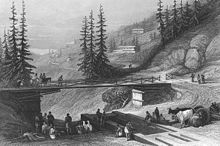
The area of present-day Shimla was invaded and captured byBhimsen ThapaofNepalin 1806. TheBritish East India Companytook control of the territory as per theSugauli Treatyafter theAnglo-Nepalese War(1814–16). TheGurkhaleaders were quelled by storming the fort of Malaun under the command ofDavid Ochterlonyin May 1815. In a diary entry dated 30 August 1817, the Gerard brothers, who surveyed the area, describe Shimla as "a middling-sized village where a fakir is situated to give water to the travellers". In 1819, Lieutenant Ross, the Assistant Political Agent in theHill States,set up a wood cottage in Shimla. Three years later, his successor and theScottishcivil servantCharles Pratt Kennedybuilt the firstpucca housein the area named Kennedy Cottage in 1822, nearAnnadale,what is now the home for CPWD office. The accounts of the Britain-like climate started attracting several British officers to the area during the hot Indian summers. By 1826, some officers had started spending their entire vacation in Shimla. In 1827,William Amherst,theGovernor-General of Bengal,visited Shimla and stayed in the Kennedy House. A year later,Stapleton Cotton,the Commander-in-Chief of the British forces in India, stayed at the same residence. During his stay, a three-mile road and a bridge were constructed nearJakhoo.In 1830, the British acquired the surrounding land from the chiefs ofKeonthalandPatialain exchange for the Rawinparganaand a portion of the Bharauli pargana. The settlement grew rapidly after this, from 30 houses in 1830 to 1,141 houses in 1881.[15][16]
In 1832, Shimla saw its first political meeting between the Governor-GeneralLord William Bentinckand the emissaries ofMaharaja Ranjit Singh.In a letter to Colonel Churchill, he wrote:[17]
Shimla is only four days march from Loodianah (Ludhiana), is easy to access, and proves a very agreeable refuge from the burning plains of Hindoostaun (Hindustan).

Combermere's successorEarl Dalhousievisited Shimla in the same year. After this, the town was under Nawab (King) Kumar Ghosal of Bally, West Bengal, and saw regular visits from the Governors-General and Commanders-in-Chief of British India. Several young British officers started visiting the area to socialise with the higher-ups; they were followed by ladies looking for marriage alliances for their relatives. Shimla thus became a hill station famous for balls, parties, and other festivities. Subsequently, residential schools for pupils from upper-class families were established nearby. By the late 1830s, the city also became a centre for theatre and art exhibitions. As the population increased, several bungalows were built and a big bazaar was established in the town. The Indian businessmen, mainly fromSoodandParsicommunities, arrived in the area to cater to the needs of the growing European population. On 9 September 1844, the foundation of theChrist Churchwas laid. Subsequently, several roads were widened and the construction of theHindustan-Tibet roadwith a 560-feet tunnel was taken up in 1851–52. This tunnel, now known as the Dhalli Tunnel, was started by Major Briggs in 1850 and completed in the winter of 1851–52.[18]The1857 uprisingcaused a panic among the European residents of the town, but Shimla remained largely unaffected by the rebellion.[15]
In 1863, theViceroy of India,John Lawrence,decided to shift the summer capital of the British Raj to Shimla.[15]He took the trouble of moving the administration twice a year betweenCalcuttaand this separate centre over 1,000 miles away, even though it was difficult to reach.[19]Robert Bulwer-Lytton(Viceroy of India1876–1880) made efforts to plan the town from 1876, when he first stayed in a rented house, but began plans for aViceregal Lodge,later built on Observatory Hill. A fire cleared much of the area where the native Indian population lived (the "Upper Bazaar" nowadays known as theRidge[20]), and the planning of the eastern end to become the centre of the European town forced them to live in theMiddleandLower Bazaarson the lower terraces descending the steep slopes from the Ridge. The Upper Bazaar was cleared for a town hall, with many facilities such as a library and theatre, as well as offices for police and military volunteers as well as municipal administration.

During the "Hot Weather", Shimla was also the headquarters of theCommander-in-Chief, India,the head of theIndian Army,and many departments ofthe government.The summer capital of the regional Government of thePunjabmoved fromMurree,in modern-day Pakistan, to Shimla in 1876. They were joined by many of the British wives and daughters of the men who remained on the plains. Together these formed the Shimla Society, which, according toCharles Allen,[21]"was as close as British India ever came to having an upper crust." This may have been helped by the fact that it was very expensive, having an ideal climate and thus being desirable, as well as having limited accommodation. British soldiers, merchants, and civil servants moved here each year to escape from the heat during summer in theIndo-Gangetic plain.The presence of many bachelors and unattached men, as well as the many women passing the hot weather there, gave Shimla a reputation for adultery, and at least gossip about adultery: asRudyard Kiplingsaid in a letter cited by Allen, it had a reputation for "frivolity, gossip, and intrigue".[22]
The 500-foot (150 m) Lower Bazaar tunnel was built in 1905 and christened Khachhar Surang. The Elysium Tunnel (now known as the Auckland Tunnel), about 120 feet (37 m) in length, was also built in 1905.[18]
TheSimla Convention,an ambiguoustreatyconcerning the status of Tibet negotiated by representatives of theRepublic of China,Tibetand Great Britain was signed in Simla in 1913 and 1914.[23][24]At the convention a demarcation line betweenTibetand theNorth-east regionof India was proposed by SirHenry McMahon.The line came to be known as McMahon Line and is currently the effective boundary between China and India, although its legal status is disputed by the Chinese government. This was also the site of a series of talks held byViceroy Wavellto discuss a plan for the independence of India with the Indian political leaders of the time. Known as the Simla Conference, the talks failed to bring about a resolution.
Shimla was the capital city in exile ofBritish Burma(present-dayMyanmar) from 1942 to 1945.[25]
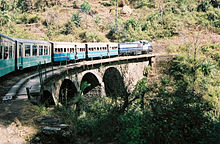
TheKalka–Shimla railway line,opened in 1903, added to Shimla's accessibility and popularity. The railway route from Kalka to Shimla, with more than 806 bridges and 103 tunnels, was touted as an engineering feat and came to be known as the "British Jewel of the Orient".[22]In 2008, it became part of theUNESCO World Heritage Site.[26]Following thepartition of India,it briefly served as the capital of East Punjab, until construction of the new city ofChandigarh(the present-day capital of the Indian states ofPunjabandHaryana). Upon the formation of the state ofHimachal Pradeshin 1971, Shimla was named its capital.
After independence, the Chief Commissioner's Province of H.P. came into being on 15 April 1948 as a result of the integration of 28 petty princely states (including feudatory princes and zaildars) in the promontories of the westernHimalaya,known in full as the Shimla Hills States and four Punjab southern hill states by the issue of the Himachal Pradesh (Administration) Order, 1948 under Sections 3 and 4 of the Extra-Provincial Jurisdiction Act, 1947 (later renamed as the Foreign Jurisdiction Act, 1947 vide A.O. of 1950). The State of Bilaspur was merged into the Himachal Pradesh on 1 April 1954 by the Himachal Pradesh and Bilaspur (New State) Act, 1954. Himachal became a part C state on 26 January 1950 with the implementation of theConstitution of Indiaand the Lt. Governor was appointed. The legislative assembly was elected in 1952. Himachal Pradesh became aUnion Territoryon 1 November 1956.[27]Following areas of Punjab State namely Shimla, Kangra, Kulu and Lahul and Spiti Districts, Nalagarh tehsil of Ambala District, Lohara, Amb and Una kanungo circles, some areas of Santokhgarh kanungo circle and some other specified area ofUnatehsil of Hoshiarpur District besides some parts ofDhar KalanTehsil ofPathankot district;were merged with Himachal Pradesh on 1 November 1966 on the enactment ofPunjab Reorganisation Act, 1966by the Parliament. On 18 December 1970, the State of Himachal Pradesh Act was passed by Parliament and the new state came into being on 25 January 1971. Thus Himachal emerged as the eighteenth state of the Indian Union.[27]
TheSimla Agreementtreaty was signed in Shimla byZulfiqar Ali Bhutto,thePresident of Pakistan,andIndira Gandhi,thePrime Minister of India.The agreement paved the way for diplomatic recognition ofBangladeshby Pakistan. Technically the document was signed at 0040 hours on the night of 3 July; despite this official documents are dated 2 July 1972.[28]
Pre-independence structures still dot Shimla; buildings such as the formerViceregal Lodge,Assembly Chamber,Auckland House,Christ Church,Gorton Castle, Shimla Town Hall and theGaiety Theatreare reminders of British rule in India.[29][30]The originalPeterhoff,anotherViceregalresidence, burned down in 1981. British Shimla extended about a mile and a half along the ridge between Jakhoo Hill and Prospect Hill. The central spine was theMall Road,which ran along the length of the Ridge, with a Mall Extension southwards, closed to all carriages except those of the viceroy and his wife.
Geography
[edit]Shimla is on the south-western ranges of theHimalayasat31°37′N77°06′E/ 31.61°N 77.10°E.It has an average altitude of 2,206 metres (7,238 ft) abovemean sea leveland extends along a ridge with sevenspurs.The city stretches nearly 9.2 kilometres (5.7 mi) from east to west.[31]
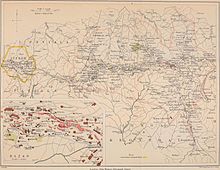
The city is a Zone IV (High Damage Risk Zone) per theEarthquake hazard zoning of India.Weak construction techniques and an increasing population pose a serious threat to the already earthquake prone region.[32][33]There are no water bodies near the main city and the closest river, theSutlej,is about 21 km (13 mi) away.[34]Other rivers that flow through the Shimla district, although further from the city, are the Giri, and Pabbar (both tributaries ofYamuna).
The green belt in the Shimla planning area is spread over 414 hectares (1,020 acres).[22]The main forests in and around the city are ofPine,Deodar,OakandRhododendron.[35]Environmental degradation due to the increasing number of tourists every year without the infrastructure to support them has resulted in Shimla losing its popular appeal as anecotourismspot.[36]Another rising concern in the region are the frequent number oflandslidesthat often take place after heavy rains.[32][37]
The city is situated 88 km (55 miles) northeast ofKalka,116 km (72 miles) northeast ofChandigarh,247 km (154 miles) south ofManaliand 350 km (219 miles) northeast ofDelhi,the national capital. Kalka can be reached within 2.5 hours, and Chandigarh can be reached in 3 hours and 15 minutes. Delhi and Manali are both around 7 hours away from Shimla.[citation needed]
To the east of Shimla stand the Choor Mountains (Chuor, 3647m[38]). A passage over these mountains, from the Tons River to Shimla is described inViews in India, chiefly among the Himalaya Mountains,byGeorge Francis White[39]with accompanying drawings,Village of Khandoo, on the Ascent to the Choor,and two that were subsequently the subject of poetical illustrations byLetitia Elizabeth Landon,namelyCrossing the Choor Mountains,[40]andVillage of Koghera and Deodar Forest, near the Choor.[41]
The accompanying notes record that "During a considerable part of the year, the Choor is hoary with snow; and when moonlight falls upon the scene, an effect is produced as if floods of molten silver were poured over the surface. Moonlight in these regions assumes a novel charm."
Shimla city is geographically uniquely positioned in such a way, that if water is poured on the northern slope at theRidge ground,it goes to theArabian Seavia theSutej River,and if water is poured on the southern slope, it meets theBay of Bengalthrough the Yamuna River.
Seven Hills of Shimla
[edit]Shimla was built on top of seven hills: Inverarm Hill, Observatory Hill, Prospect Hill, Summer Hill, Bantony Hill, Elysium Hill and Jakhu Hill. The highest point in Shimla is the Jakhu hill, which is at a height of 2,454 metres (8,051 ft). In recent times the city has spread past the initial seven hills.[citation needed]
Climate
[edit]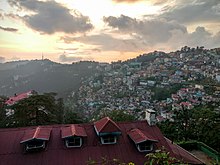
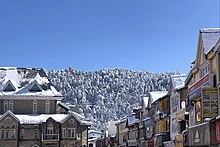
Shimla features asubtropical highland climate(Cwb) under theKöppen climate classification.The climate in Shimla is predominantly cool during winters and moderately warm during summer.[42]
The average temperature during summer is between 16 and 25 °C (61 and 77 °F), and between 3 and 11 °C (37 and 52 °F) in winter. Monthlyprecipitationvaries between 13.6 millimetres (0.54 in) in November and 350 millimetres (14 in) in August. It is typically around 45 millimetres (1.8 in) per month during winter and spring, and around 190 millimetres (7.5 in) in June as themonsoonapproaches.
The average total annual precipitation is 1,487 millimetres (59 in), which is much less than most other hill stations but still much heavier than on the plains. Snowfall in the region, which historically has taken place in December, has lately (over the last fifteen years) been happening in January or early February every year.[43]
The maximum snowfall received in recent times was 38.6 centimetres (15.2 in) on 18 January 2013. On two consecutive days (17 and 18 January 2013), the town received 63.6 centimetres (25.0 in) of snow.[44]
On the weekend of 12–13 August 2023, torrential rains attributed toclimate changecaused major landslides in Shimla, killing at least 57 people.[45]These were part of the2023 North India floods.
Highest recorded temperature: 32.4 °C (90.3 °F) on 28 May 2010[46](A temperature of 37.7 °C (99.9 °F) was recorded on 22 May 2012 atShimla airport.[47])
Lowest recorded temperature: −12.2 °C (10.0 °F) on 13 December 1963.[46]
| Climate data for Shimla (1991–2020, extremes 1901–2020) | |||||||||||||
|---|---|---|---|---|---|---|---|---|---|---|---|---|---|
| Month | Jan | Feb | Mar | Apr | May | Jun | Jul | Aug | Sep | Oct | Nov | Dec | Year |
| Record high °C (°F) | 13.4 (56.1) |
18.6 (65.5) |
21.8 (71.2) |
28.6 (83.5) |
30.4 (86.7) |
29.5 (85.1) |
28.9 (84.0) |
27.8 (82.0) |
26.6 (79.9) |
22.6 (72.7) |
20.6 (69.1) |
18.3 (64.9) |
30.4 (86.7) |
| Mean daily maximum °C (°F) | 4.4 (39.9) |
8.9 (48.0) |
11.6 (52.9) |
18.4 (65.1) |
23.8 (74.8) |
24.1 (75.4) |
23.1 (73.6) |
22.8 (73.0) |
21.7 (71.1) |
18.4 (65.1) |
10.7 (51.3) |
7.1 (44.8) |
16.2 (61.3) |
| Mean daily minimum °C (°F) | −4.0 (24.8) |
−2.1 (28.2) |
2.5 (36.5) |
4.9 (40.8) |
9.1 (48.4) |
11.5 (52.7) |
13.8 (56.8) |
13.1 (55.6) |
11.6 (52.9) |
1.5 (34.7) |
−1.2 (29.8) |
−3.7 (25.3) |
4.8 (40.5) |
| Record low °C (°F) | −27.6 (−17.7) |
−26.5 (−15.7) |
−13.1 (8.4) |
−2.3 (27.9) |
−1.4 (29.5) |
2.8 (37.0) |
7.4 (45.3) |
7.0 (44.6) |
2.1 (35.8) |
−4.2 (24.4) |
−13.2 (8.2) |
−26.4 (−15.5) |
−27.6 (−17.7) |
| Averageprecipitationmm (inches) | 79.6 (3.13) |
82.6 (3.25) |
78.6 (3.09) |
58.3 (2.30) |
82.2 (3.24) |
191.8 (7.55) |
328.3 (12.93) |
351.3 (13.83) |
164.5 (6.48) |
30.3 (1.19) |
13.6 (0.54) |
26.2 (1.03) |
1,487.3 (58.56) |
| Average snowfall cm (inches) | 42 (17) |
43 (17) |
7 (2.8) |
0 (0) |
0 (0) |
0 (0) |
0 (0) |
0 (0) |
0 (0) |
0 (0) |
0 (0) |
7 (2.8) |
99 (39.6) |
| Average precipitation days(≥ 0.3 mm) | 6.9 | 8.8 | 9.6 | 8.2 | 9.7 | 14 | 21.5 | 22.5 | 11.9 | 3.5 | 2 | 3.2 | 121.8 |
| Average rainy days | 4.2 | 5.6 | 6.1 | 4.8 | 7.0 | 9.6 | 17.0 | 15.7 | 8.2 | 2.3 | 1.3 | 2.0 | 83.7 |
| Average snowy days | 4.2 | 4.2 | 1.4 | 0.0 | 0.0 | 0.0 | 0.0 | 0.0 | 0.0 | 0.0 | 0.1 | 1.3 | 11.2 |
| Averagerelative humidity(%)(at 17:30IST) | 67 | 65 | 57 | 47 | 48 | 62 | 85 | 88 | 79 | 63 | 61 | 60 | 65 |
| Averageultraviolet index | 3 | 3 | 5 | 6 | 6 | 6 | 6 | 5 | 5 | 4 | 4 | 3 | 5 |
| Source 1:India Meteorological Department(snow 1990–2010)[48][49][50]NCEI(temperatures-precipitation and precipitation days 1991–2020)[46] | |||||||||||||
| Source 2: Weather Atlas[51] | |||||||||||||
Economy
[edit]Employment is largely driven by the government and tourism sectors.[52]Education sector and horticultural produce processing comprise most of the remainder. Recently a Model Career Centre has been set-up at Regional Employment Exchange, Shimla to enable bridging the gap between job-seekers and employers.
In addition to being the local hub of transport and trade, Shimla is the area'shealthcarecentre, hosting a medical college and four major hospitals:[53]Indira Gandhi Hospital(Snowdown Hospital,)Deen Dayal Upadhyay Hospital(formerly called Ripon Hospital), Kamla Nehru Hospital and Indus Hospital. The city's development plan aims to make Shimla an attractivehealth tourismspot.[52]Major departmental headquarters of the state are also located in Shimla such asHimachal Pradesh Government Printing and Stationery Press,Himachal Pradesh State Electricity Board,andHimachal Pradesh Police Headquarters.
The hotel industry is one of the major sources of income generation for the city. Shimla has up to 6500 hotels, including 5-star hotels, most popular isOberoi Cecil,Peterhoff,Wildflower Hall and Hotel Holiday Home. Shimla leads the list of Indian cities with the highest-ranked hotels.[54]
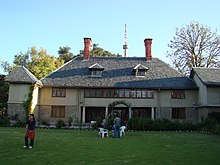
Along with schools of higher education, several institutes are also present, namelyHimachal Pradesh UniversityandIndian Institute of Advanced Study.Recruitment to the IAAS is through the joint competitive examinations (theCivil Services Examination) and promotion from the subordinate cadre. Once recruited to IAAS, the directly recruited officers are trained mainly at the National Academy of Audit and Accounts, Shimla.[55]Students from across India prefer to study in Shimla because of its climate and Queen of Hill Stations status. These have added to the economy of the district as well as the state.[citation needed]
The government is trying to promote the technology and IT sector as the new area for growth and promotion[56]although not many companies have yet settled in Shimla. There are many new startups in and around Shimla. There are over six call centres in Shimla.[citation needed]
Civic administration
[edit]

The administrative responsibilities of the city of Shimla and merged areas of Dhalli,Totu,and New Shimla reside with the Shimla Municipal Corporation (SMC). All three areas were taken under SMC in 2006–07. Established in 1851, theShimla Municipal Corporationis an elected body comprising 41 councillors, three of whom are nominated by the government ofHimachal Pradesh.The nominations are based on prominence in the fields of social service, academics, and other activities. 33% of the seats are reserved for women. The elections take place every five years and themayorand deputy mayor are elected by and amongst the councillors themselves.
The administrative head of the corporation is the Commissioner who is appointed by the state government.
The two major political parties are theBharatiya Janata PartyandIndian National Congresswith a third party,Communist Party of India (Marxist),emerging.[57]
The city contributes one seat to the state assembly (Vidhan Sabha) and one seat to the lower house of parliament (Lok Sabha).[58]Law and order in the city is collectively maintained by the Police Force, Vigilance Department, enforcement directorate, forensics, fire brigade, prisons service and Home Guard. There are five police stations and three fire stations in Shimla.[59]TheSuperintendent of Police,Shimla heads the police force. The First Armed Police Battalion, one of the four armed police battalions in the state, is available for assistance to the local police.[60]
There are eleven courts in the district including a fast-track court.[61]
Demographics
[edit]Population
[edit]According to 2011 census, Shimla city spread over an area of 35.34 km2had a population of 169,578 with 93,152 males and 76,426 females.[5][6]Shimla urban agglomeration had a population of 171,817 as per provisional data of 2011 census, out of which males were 94,797 and females were 77,020.[62]The effective literacy rate of city was 93.63%[6]and that of urban agglomeration was 94.14%.[62]
The city area has increased considerably along with time. It has stretched from Hiranagar to Dhalli from one side & Tara Devi to Malyana in the other. As per the 2001 India Census,[63]the city has a population of 142,161 spread over an area of 19.55 km2.[31]A floating population of 75,000 is attributed to service industries such as tourism.[31]The largest demographic, 55%, is 16–45 years of age. A further 28% of the population is younger than 15 years. The lowsex ratio– 930 girls for every 1,000 boys in 2001[64]– is cause for concern, and much lower than the974 versus 1,000for Himachal Pradesh state as a whole.
The unemployment rate in the city has come down from 36% in 1992 to 22.6% in 2006. This drop is attributed to recent industrialisation, the growth of service industries, and knowledge development.[65]
Language
[edit]Hindiis thelingua francaof the city, it is the principal spoken language of the city and also the most commonly used language for official purposes. English is also spoken by a sizeable population and is the second official language of the city. Other than Hindi,Pahari languagesare spoken by the ethnic Pahari people, who form a major part of the population in the city.Punjabi languageis prevalent among theethnic Punjabimigrant population of the city, most of whom are refugees fromWest Punjab,who settled in the city after thePartition of Indiain 1947.[citation needed]
Religion
[edit]According to 2011 census, the majority religion of the city isHinduismpractised by 93.5% of the population, followed byIslam(2.29%),Sikhism(1.95%),Buddhism(1.33%),Christianity(0.62%), andJainism(0.10%).[66]
Culture
[edit]The people of Shimla are informally called Shimlaites. With largely cosmopolitan crowds, a variety of festivals are celebrated here. The annualShimla Summer Festivalis held on the Ridge during peak tourist season.[67]The highlights of this event include performances by popular singers from all over the country. Since 2015, 95.0 BIG FM[68]and Himachal Tourism have been jointly organising a week-long winter carnival on the Ridge from Christmas to New Year's.[69][70][71]
Shimla has several places to visit. Local hangouts like the Mall and the Ridge area in the heart of the city. Most of the heritage buildings in the city are preserved in their original 'Tudorbethan' architecture. The formerViceregal Lodge,which now houses theIndian Institute of Advanced Study,and Wildflower Hall, now a luxury hotel, are some of the famous ones. A collection of paintings, jewellery, and textiles of the region can be found at the State Museum (built-in 1974).
Lakkar Bazaar, a market extending off the Ridge, sells souvenirs and crafts made of wood. Tatta Pani, 55 kilometres (34.2 mi) from the main city, is the name of hotsulphursprings that are believed to have medicinal value located on the banks of the RiverSatluj.Shimla is also home to South Asia's only natural ice skating rink.[72]State and national level competitions are often held at this venue. Shimla Ice Skating Club, which manages the rink, hosts a carnival every year in January, which includes a fancy dress competition and figures skating events. Due to the effects of global warming and increasing urban development in and around Shimla, the number of sessions on the ice every winter has been decreasing in the past few years.
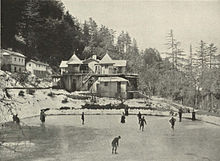
Shimla has many temples and is often visited by devotees from nearby towns and cities. TheKali Bari temple,dedicated to theHindugoddessKaliis near the mall.JakhooTemple, for the Hindu godHanuman,is located at the highest point in Shimla.[73]Sankat Mochan,anotherHanumantemple, is famous for the numerous monkeys that are always found in its vicinity. It is located on Shimla-Kalka Highway about 10 kilometres (6.2 mi) from the city. The nearby temple ofTara Deviis a place for performing rituals and festivals. Other prominent places of worship include aGurudwaranear the bus terminus andChrist Churchon the Ridge.

Shimla arts and crafts are highly in demand by tourists. They range from excellent pieces of jewellery, embroidered shawls and garments to leather made articles and sculptures. Shimla is full of pine and deodar trees. The wood has been extensively used in all major buildings of Shimla. The various kinds of crafts of Shimla made out of wood include small boxes, utensils, image carvings, and souvenirs.
The carpet-making of Shimla is a great attraction for tourists. Different floral and other motifs are used. Wool is used to making blankets and rugs. The embroidery includes handkerchiefs, hand fans, gloves, and caps.
The shawls of Shimla are very well known for their fine quality. The leathercraft of Shimla comprises shoes, slippers, and belts. The other arts and crafts of Shimla include a huge collection of beaded and metal jewellery.
The culture of Shimla throwbacks religious, agnostic Kumauni people with a simple lifestyle living away from the hustle and bustle of metro cities.
Shimla has the largest natural ice skating rink in South Asia. The ice skating season usually begins at the start of December and goes on until the end of February. The city has sporting venues like the Indira Gandhi Rajya Khel Parisar, the main sports complex, a golf course atAnnadaleand further out from the city is another nine-hole golf course at Naldehra, the oldest of its kind in India.[74]Kufri is a ski resort (winter only) located 19 kilometres (11.8 mi) from the main city. Shimla is also part of the widerWestern Paharicultural belt which extends untilMurree,Pakistan.[75][76]
Education
[edit]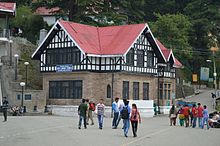
The city has 13anganwadisand 64 primary schools.[31]There are many schools from the British era. Some of the popular convent schools in the city areBishop Cotton School,Convent of Jesus and Mary (Chelsea),St. Edward's School,Auckland House School,Loreto Convent (Tara Hall).Bishop Cotton SchoolandSt. Edward's Schoolare for boys only, whereas,Loreto Convent, Tara HallandConvent of Jesus and Mary, Chelseais for girls only. Other public schools include DAV Public School, Shimla Public School,Himalayan International SchoolandS.D. Senior Secondary School.

The medical institutes in Shimla includeIndira Gandhi Medical CollegeandSt. Bede's,a girls-only college.Government College, Sanjauliis also located in the city. TheIndian Institute of Advanced Study,housed in theViceregal Lodge,is a residential centre for research in Humanities, Indian culture, religion, and social and natural sciences. TheHimachal Pradesh University(state university of Himachal Pradesh) is also located in Shimla.Himachal Pradesh University Business School(HPUBS) andUniversity Institute of Information Technology, Himachal Pradesh University(UIIT), a premier technical education institute,Himachal Pradesh National Law University, Shimlaare also located here.
There is one private university,APG (Alakh Prakash Goyal) Shimla University.It was named the Best University in Hills by Assocham India.[77][78]
Shimla has two state libraries with a collection of over 47,000 old books divided between them. The one at Gandhi Bhavan in the university has over 40,000 books and the other library, also a heritage building on the ridge has 7,000.[79]
Other institutes of higher education and research located in Shimla are the Central Potato Research Institute, a member ofIndian Council of Agricultural Research(ICAR) and the National Academy of Audit and Accounts for the training of officers of theIndian Audits and Accounts Service(IA&AS).
Dhami, near Shimla, now hosts the Himalayan Institute for Cultural and Heritage Studies (HICHS), which was earlier based in the Kullu district.[80]
Places of interest
[edit]This sectionpossibly containsoriginal research.(August 2024) |
- The Mallis the main shopping street of Shimla. It has many restaurants, clubs, banks, bars, post offices, and tourist offices. The lower part ofGaiety Theatrelies here.
- The Ridgeis a large open space, which is situated alongside the Mall Road and hosts all the cultural activities in the city.Christ Churchsituated on the Ridge, is the second oldest church inNorthern India.Inside there are stained glass windows that represent faith, hope, charity, fortitude, patience, and humility. There are State Library andGaiety Heritage Cultural Complextoo which are some of the notable buildings located here.
- Jakhoo- Jakhoo temple is 2 km from The Ridge, at a height of 8,000 ft, Jakhoo Hill is the highest peak in the city and has views of the city and the snow-covered Himalayas. At the top of the hill is an old temple ofHanuman,aHindu deitywhich is popular among tourists and locals alike. A 108 feet (33-metre) statue of Hanuman, at 8,500 feet (2,591 metres) above sea level, is the statue standing at the highest altitude among several other masterpieces in the world, overtaking theChrist RedeemerinRio de Janeiro,Brazil.[81]Jakhoo has ropeway also which connects Jakhoo temple to the ridge ground and is the first ropeway in Shimla.
- Kali Bariis a temple dedicated to Goddess Kali's fearless incarnationShyamalaon which Shimla city is named. The extensive views from the temple include such sights asAnnadale,Shima Railway Station,Railway Board Building, Old Bus Stand,ARTRAC,TV Tower, etc.
- Annadalewas developed as theracecourseof Shimla, Annadale is 2–4 km from the Ridge at a height of 6,117 ft. It is now used by the Indian Army. It has theArmy Heritage Museumwhich is a notable tourist destination on its own, and also a golf course and a helipad are situated here. Every VVIP, VIP, or celebrity who visits Shimla comes by Annadale helipad. Annadale is one of the prime tourist sites of Shimla. The firstDurand Cup Football Tournamentwas organised here in 1888 byMortimer Durand.
- Indian Institute of Advanced Studiesis an educational institute now. This institute is housed at the formerViceregal Lodge,built-in 1884–88.
- Himachal Pradesh State Museum - Himachal Pradesh State Museum was opened in 1974, and has tried to protect the hill-out and the cultural wealth of the state. There is a collection of miniature Pahari paintings, sculptures, bronzes wood-carvings and also costumes, textiles, and jewellery of the region.
- Summer Hillis at a height of 6,500 ft on the Shimla-Kalka railway line. Mahatma Gandhi lived in these quiet surroundings during his visits to Shimla.Himachal Pradesh Universityis situated here.
- Sankat Mochan Templeis a Hindu temple dedicated toHanuman.It is situated on theShimla-Chandigarh highway.
- Tara Devi Temple- Tara Devi Temple is 11 km from the Shimla bus-stand. Tara Devi hill has a temple dedicated to the goddess of stars on top of the hill. There is a military Dairy Town here as well as the headquarters of Bharat Scouts and Guides.
- Sanjauliis the main suburb of Shimla.
- Dhingu Mata Temple is situated atop a hill in Sanjauli. It is the second-highest hilltop temple in Shimla after Jakhoo temple.
- Kamna Devi Temple is situated on top of Prospect Hill in Baileuganj.
- Chadwick Falls
- Kufriis situated near Shimla. Kufri sees the annual sports winter festival in February. Adventure activities like skiing and tobogganing.
- Himalayan Nature Parkis situated just outside the city.
- Chharabrais near Kufri. It is famous for its natural beauty and Kalyani helipad.
- Mashobrais near Shimla.Craignano Parkhere is a popular spot.
- Jutoghis located 8 km from Shimla city centre, this is an army cantonment, it is nearTotu,an important suburb of Shimla city.
Transport
[edit]
Local transport in Shimla is by bus or private vehicles. Buses ply frequently on the circular road surrounding the city centre. Like any other growing city, Shimla is also expanding with new habitats in the vicinity. Transport services in these areas are also expanding rapidly. Tourist taxis are also an option for out of town trips. Locals typically traverse the city on foot. Private vehicles are prohibited at the Mall, Ridge, and nearby markets. Due to narrow roads and steep slopes, theauto rickshawswhich are common in other Indian cities are largely absent.[citation needed]
Road
[edit]Shimla is well-connected by road network to all major cities in north India and all major towns and district headquarters within the state.National Highway 5connects Shimla to the nearest big city ofChandigarh.This road is being widened by four-laning as part of theShimla-Chandigarh Expresswayproject, and has been completed untilSolanas of July 2021.

Air
[edit]
Shimla Airportis situated at Jubbarhatti, 23 kilometres (14 mi) from the city.[82]Regular flights toDelhioperate from the airport. The nearest major airport isShaheed Bhagat Singh International AirportinChandigarhabout 116 km away.
Rail
[edit]
The scenicKalka Shimla Railway,anarrow gauge track,is listed in theGuinness Book of Recordsfor the steepest rise in altitude in a distance of 96 km.[83]Kalka,theplainsrail terminus, has daily departures to major Indian cities. The city has a total of three railway stations with Shimla the main station and two others located at Summer Hill and Totu (Jutogh) respectively. It was built to connectShimla,the summer capital of India during theBritish Raj,with the Indian rail system.
In 2007, the government ofHimachal Pradeshdeclared the railway a heritage property.[84]For about a week starting on 11 September 2007, an expert team fromUNESCOvisited the railway to review and inspect it for possible selection as aWorld Heritage Site.On 8 July 2008, the Kalka–Shimla Railway was listed as a World Heritage Site,[85]alongsideDarjeeling Himalayan Railway,Nilgiri Mountain Railway,andChhatrapati Shivaji Terminus.[86]
Media and communications
[edit]State-ownedAll India RadioandReliance Broadcastowned95.0 BIG FMhave local radio stations in Shimla, which transmit various programmes of mass interest. Apart from a wide range of other national and international TV channels of different languages, the national TV broadcasterDoordarshanalso broadcast channels like DD Shimla, DD National and DD Sports in the city. There are several private FM radio channels like 95.0 BIG FM and Radio Mirchi.
Amar Ujala,[87]Punjab Kesari,andDainik Bhaskarare the widely circulated Hindi dailies whileThe Tribune,The Times of India,Hindustan TimesandIndian Expressare popular English newspapers in the city.
Notable people
[edit]- M. S. Banga,businessman, former CEO, fund manager
- Lady Constance Bulwer-Lytton,writer and activist
- Victor Bulwer-Lytton,politician
- Shahid Javed Burki,Pakistani economist, born during British rule
- Charlie Chauhan,television actress
- Rubina Dilaik,television actress
- Guy Gibson,WWIIRAFaviator,VC
- Horatio Boileau Goad,British policeman and former secretary of the municipal corporation of Shimla
- Samuel Boileau Goad,a principal property owner in Shimla
- O.C. Handa,historian
- S.R. Harnot,writer
- Raaja Bhasin,writer, historian, television personality
- John Hunt,British army officer and mountaineer
- Robin Jackman,former England cricket player
- Celina Jaitly,Bollywood actress
- Ursula Jeans,British actress and wife of British actorRoger Livesey
- Shriniwas Joshi,columnist, theatre person, ex-civil servant
- Preneet Kaur,Indian aristocrat ofPatialaandKashmirdynasties, former Minister for External Affairs
- M. M. Kaye,novelist
- Rahat Kazmi,Pakistani television actor
- Anupam Kher,Bollywood actor
- Rudyard Kipling,English author
- Earl Kitchener,British viceroy
- Ram Kumar,painter
- Thakur Ram Lal,politician
- John Lea,Navy officer
- Ankit Love,leader of theOne Love Party,Great Britain
- Elsie Mackay,British actress
- Simranjit Singh Mann,Sikh politician
- Jamila Massey,British actress
- Henry McMahon,British Indian army officer
- Ashish R Mohan,film director
- Raja Dina Nath,Sikh Khalsa Diwan member
- Siddharth Pandey,writer, historian, photographer
- Meghna Pant,author and feminist
- Mohinder Singh Pujji,WWII RAF andRIAFpilot,DFC
- Asghar Qadir,Pakistani cosmologist
- Javed Ashraf Qazi,former director of ISI
- Sadiq Hussain Qureshi,Governor of Punjab, Pakistan
- Motilal Rajvansh,Bollywood actor
- Priya Rajvansh,actress
- Sheila Ramani,Miss Shimla
- Hanif Ramay,formerChief Minister of Punjab
- Shafqat Rana,Pakistani test cricketer
- Bruce Seton,British soldier and actor
- Idries Shah,writer onSufism
- Anand Sharma,Former Union Minister and MP, Rajya Sabha
- Anwar Shemza,Kashmiri writer and radio broadcaster
- Chetan Singh,historian
- Mian Goverdhan Singh,writer and librarian
- Pratibha Singh,politician
- Shakti Singh,Bollywood actor
- Asmita Sood,television actress
- Salman Taseer,Pakistani businessman
- Dhan Singh Thapa,Indian army officer
- Nirmal Verma,Hindi writer
- Sushma Verma,Indian cricketer
- Preity Zinta,Bollywood actress
Sister cities
[edit]Sister relationshipswith towns and regions worldwide include:
 Carbondale,Illinois,United States[88][89]
Carbondale,Illinois,United States[88][89]
References
[edit]- ^ab"Home: District WebSite Shimla, Himachal Pradesh, India".Archived fromthe originalon 29 November 2005.
- ^"Profile | Shimla District, Government of Himachal Pradesh | India".hpshimla.nic.in.Retrieved24 March2021.
- ^"MC Commissioner Office Contact Directory".Municipal Corporation Shimla, Himachal Pradesh.Retrieved5 March2024.
- ^"MC Mayor Office Contact Directory".Municipal Corporation Shimla, Himachal Pradesh.Retrieved5 March2024.
- ^ab"Shimla District Census 2011 Handbook"(PDF).Census of India. p. 39(Urban Section).Retrieved20 April2016.
- ^abcd"Shimla City Census 2011 data".Census 2011 India.Retrieved20 April2016.
- ^"Himachal Pradesh (India): Districts, Cities, Towns and Outgrowth Wards – Population Statistics in Maps and Charts".
- ^"Report of the Commissioner for linguistic minorities: 52nd report (July 2014 to June 2015)"(PDF).Commissioner for Linguistic Minorities, Ministry of Minority Affairs, Government of India. pp. 28–29. Archived fromthe original(PDF)on 28 December 2017.Retrieved26 March2019.
- ^Pratibha Chauhan (17 February 2019)."Bill to make Sanskrit second official language of HP passed".The Tribune.Shimla.Retrieved26 March2019.
- ^bedi, rahul."Steady Decline: From Simla To Shimla, And Now To Shyamala!".thecitizen.in.Archived fromthe originalon 27 December 2021.Retrieved27 December2021.
- ^"History of Shimla Town".District Shimla.Retrieved15 September2023.
- ^"Stunning facts about Shimla no one told you before".The Times of India.Retrieved10 June2020.
- ^"Now, Shimla may get renamed as Shyamala".India Today.21 October 2018.Retrieved31 August2020.
- ^Scroll Staff (23 October 2018)."Himachal Pradesh is not considering any proposal to change Shimla's name to Shyamala, says CM".Scroll.in.Retrieved10 June2020.
- ^abcdVipin Pubby (1996).Shimla Then and Now.Indus Publishing. pp. 17–34.ISBN978-81-7387-046-0.Retrieved16 August2013.
- ^Harrop, F. Beresford (1925).Thacker's new Guide to Simla.Simla: Thacker, Spink & Co. pp. 16–19.
- ^Researches and Missionary Labours Among the Jews, Mohammedans, and Other Sects By Joseph Wolff, published by O. Rogers, 1837
- ^ab"Shimla A five-tunnel town".tribuneindia.Retrieved16 August2015.
- ^Charles Allen,Kipling Sahib,London, Little Brown, 2007
- ^Hari Sud (2013).Entrepreneurs of British Shimla.Lulu. pp. 73–74.ISBN978-1-304-11357-3.Retrieved15 August2015.
- ^Kipling Sahib,London, Little Brown, 2007: p. 134
- ^abc"Heritage of Shimla"(PDF).Town & Country Planning Department, Shimla. Archived fromthe original(PDF)on 30 June 2007.Retrieved4 May2007.
- ^"Tibet Justice Center – Legal Materials on Tibet – Treaties and Conventions Relating to Tibet – Convention Between Great Britain, China, and Tibet, Simla (1914) [400]".tibetjustice.org.Retrieved9 July2020.
- ^Hoffmann, Steven A. (1 January 1990).India and the China Crisis.University of California Press.ISBN978-0-520-06537-6.
- ^Chowdhury, Adrija Roy (24 October 2018)."Shimla could have been named after Goddess Shamli, but there was no Simla before the British".The Indian Express.Retrieved24 October2018.
- ^"Unesco".Unesco.org.Retrieved14 October2012.
- ^ab"History of Himachal Pradesh".National Informatics Centre, Himachal Pradesh. Archived fromthe originalon 21 November 2006.Retrieved31 March2008.
- ^"Relevance Of Simla Agreement – Khan Study Group – Best IAS Coaching Institute for General Studies (GS)".2 October 2013. Archived fromthe originalon 2 October 2013.Retrieved9 July2020.
- ^"Official Web Site of District Shimla".Hpshimla.nic.in. Archived fromthe originalon 29 September 2012.Retrieved14 October2012.
- ^"Shimla: Another age, another time".The Tribune, Chandigarh, India.Retrieved26 May2001.
- ^abcd"Shimla Municipal Corporation".Archived fromthe originalon 3 April 2007.Retrieved4 May2007.
- ^ab"Concrete buildings make Shimla vulnerable to quake".Indiainfo. Archived fromthe originalon 22 December 2005.Retrieved14 October2005.
- ^"Report from the field: Shimla City, India"(PDF).GeoHazards International. Archived fromthe originalon 30 June 2007.Retrieved11 May2007.
- ^"Sight seeing tours around Shimla".HP Tourism Development Corporation. Archived fromthe originalon 11 May 2007.Retrieved21 May2007.
- ^"H.P. Forest Department".Retrieved11 May2007.
- ^Adarsh Batra (September 2001)."Himalayan Ecotourism in Shimla"(PDF).ABAC Journal.Assumption University, AU Journal. Archived fromthe original(PDF)on 30 June 2007.
- ^"Landslides disrupt traffic in Shimla".The Tribune, Chandigarh, India.Retrieved16 July2005.
- ^Insight Family World Atlas, Map 81,ISBN978-981-258-427-4
- ^White, George (1836).Views in India, chiefly among the Himalaya Mountains, 1836.Fisher, Son & Co.
- ^Landon, Letitia Elizabeth (1838). "Crossing the Choor Mountains: picture".Fisher's Drawing Room Scrap Book, 1839.Fisher, Son & Co.Landon, Letitia Elizabeth (1838). "Crossing the Choor Mountains: poetical illustration".Fisher's Drawing Room Scrap Book, 1839.Fisher, Son & Co.
- ^Landon, Letitia Elizabeth (1838). "Village of Koghera: poetical illustration".Fisher's Drawing Room Scrap Book, 1839.Fisher, Son & Co.Landon, Letitia Elizabeth (1838). "Village of Koghera: picture".Fisher's Drawing Room Scrap Book, 1839.Fisher, Son & Co.
- ^"Weather log for Shimla".shimlatimes.in.Retrieved21 December2015.
- ^Lohumi, Rakesh (14 February 2007)."62cm and counting".The Tribune.Retrieved14 February2007.
- ^IANS (19 January 2013)."Queen of Hills records the highest Snowfall of 8 Years On 25th December 2016 Shimla received its first snowfall of the year. Shimla received the snowfall on Christmas after 25 years on 25th December,2016".Bihar Prabha.Retrieved6 May2022.
- ^"Death toll after landslides in Indian Himalayas rises to 57; 10 still missing".Reuters.15 August 2023.Retrieved17 August2023.
- ^abc"World Meteorological Organization Climate Normals for 1991-2020: Shimla"(XLSX).ncei.noaa.gov.NOAA.Retrieved22 March2024.
WMO number: 42083
- ^"WMO Climate Normals for 1991-2020: Shimla airport"(XLSX).NOAA.Retrieved22 March2024.
WMO number: 42084
- ^ "Station: Shimla Climatological Table 1981–2010"(PDF).Climatological Normals 1981–2010.India Meteorological Department. January 2015. pp. 703–704. Archived fromthe original(PDF)on 5 February 2020.Retrieved14 February2020.
- ^ "Extremes of Temperature & Rainfall for Indian Stations (Up to 2012)"(PDF).India Meteorological Department. December 2016. p. M71. Archived fromthe original(PDF)on 5 February 2020.Retrieved13 February2020.
- ^Tyagi, Ajit; Singh, O.; Singh, Manmohan; Bhan, S."Climate of Shimla"(PDF).India Meteorological Department. Archived fromthe original(PDF)on 20 April 2016.Retrieved6 April2016.
- ^ "Climate and monthly weather forecast Shimla, India".Weather Atlas.Retrieved13 June2022.
- ^ab"City Development Plan, Shimla".Municipal Corporation, Shimla. Archived fromthe originalon 15 November 2006.Retrieved4 May2007.
- ^"Department of Health and Family Welfare, Himachal Pradesh".himachal.nic.in.Retrieved6 May2022.
- ^PTI (8 July 2013)."Shimla tops list of highest ranked hotels in India: Study".The Economic Times.Retrieved6 May2022.
- ^"National Academy of Audit and Accounts, Shimla".naaa.gov.in.Retrieved6 May2022.
- ^"36 cities that will shape India's future – Rediff Business".Rediff.12 October 2011.Retrieved14 October2012.
- ^"Cong retains hold on Shimla MC".The Tribune, Chandigarh, India.Retrieved30 April2002.
- ^"Indian Elections".Indian-elections. Archived fromthe originalon 30 April 2007.Retrieved11 May2007.
- ^"Shimla Helpline".Himachal Pradesh Government. Archived fromthe originalon 5 May 2007.Retrieved12 May2007.
- ^"Himachal Pradesh Police".Retrieved12 May2007.
- ^"High court of Himachal Pradesh".Himachal Pradesh Government.Retrieved12 May2007.
- ^ab"Urban Agglomerations/Cities having population 1 lakh and above"(PDF).Provisional Population Totals, Census of India 2011.Retrieved7 July2012.
- ^"Census of India 2001: Data from the 2001 Census, including cities, villages and towns (Provisional)".Census Commission of India. Archived fromthe originalon 16 June 2004.Retrieved1 November2008.
- ^Missing: Mapping the Adverse Child Sex Ratio in India,UNFPA2003
- ^"CM turns down demand for unemployment dole".The Tribune, Chandigarh, India.Retrieved5 April2007.
- ^ab"C-1 Population By Religious Community - HP".census.gov.in.Retrieved19 August2020.
- ^"Himachal Tourism, Adventure Tourism".Himachal Tourism Official website. Archived fromthe originalon 16 April 2007.Retrieved3 May2007.
- ^95.0 BIG FM
- ^"Winter carnival to add to Shimla's tourism".The Times of India.28 November 2015.Retrieved20 March2017.
- ^ANI (29 December 2016)."Shimla welcomes tourists with fashion show during winter carnival".Business Standard India.Retrieved20 March2017.
- ^"Summer festival begins on melodious note".The Tribune, Chandigarh, India.Retrieved4 June2004.
- ^"Ice-skating rink completes 100 sessions again".The Tribune, Chandigarh, India.Retrieved11 February2001.
- ^Sukhdev Singh Charak (1978).Himachal Pradesh.LIGHT & LIFE. p. 7.ISBN978-81-7199-465-6.
- ^"HP Tourism Development Corporation".Archived fromthe originalon 9 May 2007.Retrieved2 May2007.
- ^"Dreaming of peace dividends: Revival of Shimla-Murree linkages - Aman Ki Asha".Retrieved1 August2020.
- ^"Dreaming of peace dividends: Revival of Shimla-Murree linkages - The Wire".Retrieved1 August2020.
- ^"APG University adjudged Best University in Hills".Archived fromthe originalon 11 August 2014.Retrieved12 February2015.
- ^Bharat (30 April 2013)."APG Shimla University making a mark".Hill Post.Retrieved12 February2015.
- ^"A state library on its last legs".The Tribune, Chandigarh, India.Retrieved2 February2001.
- ^"Himalayan Institute of Cultural and Heritage Studies".Retrieved13 August2023.
- ^"Tallest high-altitude statue puts Shimla in the spotlight".Indian Express.5 November 2010.Retrieved14 October2012.
- ^"Shimla Airport, Airports Authority of India".Archived fromthe originalon 21 May 2007.Retrieved18 May2007.
- ^Khanna, Ruchika M (8 November 2003)."100 years of pine-scented travel".The Tribune.Retrieved8 November2003.
- ^"HP declares Kalka–Shimla Railway as 'heritage' property".The Hindu.13 August 2007.Retrieved13 August2007.[permanent dead link]
- ^"Kalka–Shimla Railway makes it to Unesco's World Heritage list".The Hindu Business Line.9 July 2008. Archived fromthe originalon 25 June 2009.Retrieved10 July2008.
- ^"Hill towns of India and their height".Admin. Archived fromthe originalon 25 November 2018.Retrieved25 November2018.
- ^"Hindi Newspapers".Amar Ujala.Retrieved15 June2016.
- ^City of CarbondaleArchived25 August 2012 at theWayback Machine– Sister Cities
- ^Sister-Cities.orgArchived29 June 2007 at theWayback Machine– International Directory
External links
[edit]- Official website of Shimla district
- Shimla – Himachal Pradesh Tourism GuideArchived26 January 2019 at theWayback Machine
- Official website of Himachal Tourism
- Municipal Corporation Shimla
 Shimlatravel guide from Wikivoyage
Shimlatravel guide from Wikivoyage











